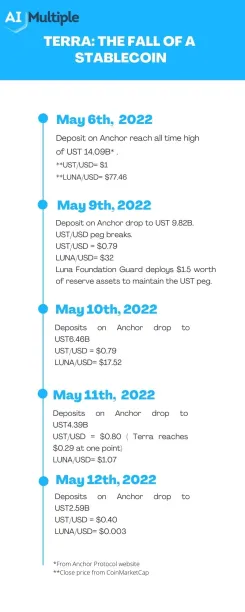Terra in 2024: The Fall of a Stablecoin
Terra, an algorithmic stablecoin, has lost its peg to the US dollar and as of May 2022 has dropped to $0.26 from $1 in five days, marking a 74% decline. This has resulted in the whipping out of more than $15 Billion. In this article, we’ll explore Terra, reasons for its crash, and its aftermath.
How does the Terra protocol work?
Terra has 2 tokens:
- Terra: Stablecoin tracing price of fiat currencies. Terra is an algorithmic stable coin, which means it is pegged to real-world currencies and is maintained through an algorithm without having actual backing from real word assets such as US dollars or gold.
- Luna: Used for governance & mining and to absorb the price volatility of Terra.
Terra protocol promises a fixed exchange rate of 1 Tera for $1 worth of Luna. For example, if the price of Luna is $0.2 then 1 Terra will give you 5 Luna. If Luna trades at $10, 1 Terra will give you 0.10 Luna. 1 Terra will always give you $1 worth of Luna.
When UST is bought or minted,$1 worth of Luna is burned. This process works the other way around too.
What happens if the price of Terra (UST) goes above or below $1?
If UST/USD > $1:
- Arbitrageurs buy $1 worth of Luna.
- Swap them for 1 UST ( Luna is burned, UST issued)
- Make an instant risk-free profit and put downward pressure on Terra to go back to the $1 peg value.
If UST/USD < $1:
- Arbitrageur buy 1 Terra for less than $1
- Swap it for $1 worth of luna (Luna is minted, UST burned)
- Make an instant risk-free profit and put upward pressure on Terra to go back to the $1 peg value.
Algorithmic stable coins are perception and demand-based and are not intrinsically stable.
Why did it crash?
The root of the problem starts with the Anchor protocol. Anchor is the main lending & borrowing protocol on the Terra ecosystem.
The majority of Terra was deposited on Anchor. In the week before the crash, on average 75% of Terra’s market cap was deposited on Anchor, probably due to its unimaginable high deposit APY of 19.12%.
There was 14.09B worth of Terra tied up in deposits on Anchor on Friday, 6th of May and it dropped to UST 2.59 Billion by Thursday, 9th of May. The decrease in the amount of the deposits meant that investors were dumping their Terras in the open market causing the value of Terra to decrease. The price decrease in Terra increased the issuance of Luna tokens due to the Terra protocol which eventually led to a death spiral, crushing Luna’s price by 99%.

Anchor has been offering a high level of APY which is not sustainable because the interest revenue from borrowers and yield generation on collaterals are not covering the interest payments, making the Terra foundation inject reserves to top up the depleting reserves. This is shown by the decreasing Anchor’s yield reserves. Decreasing yield reserves means that the yield paid to the depositors is outrunning the return on the collateral of the borrowers.
It is all about investors believing that Terra is worth something. If investors lose their faith then the Terra ecosystem won’t be able to function. The crash in the peg of Terra and the value of Luna is a clear sign that investors have lost their faith in this ecosystem.
What did Terra developers do?
In order to keep the peg, Luna Foundation Guard which is the entity set up to defend Terra’s peg lend out $1.5 billion worth of its reserve assets in Bitcoin and Terra but the move did not have much of an impact as the price of Luna has become almost zero and Terra is trading much lower than $1.
The impact
There have been a lot of talks about the risks of stablecoins and the need for regulation. The US Federal Reserve noted that a loss of confidence in stable coins can trigger bank run-like events which would decrease the whole trust in the digital economy.
The crash of Terra has probably reinforced lawmakers’ will for imposing new regulations and control measures in the stable coins space notably. Jannet Yellen, US Treasury secretary, called for regulation in the stablecoin market after Terra’s crash.
Cryptocurrency investments are always risky. In order to avoid fraudulent projects, we have created an in-depth guide to choose a winning cryptocurrency project and avoid scammy ones. We have analyzed various cryptocurrency projects that promise wealth but provide users with nothing. You can read:
If you have questions about Terra or other cryptocurrencies, feel free to ask:

Cem has been the principal analyst at AIMultiple since 2017. AIMultiple informs hundreds of thousands of businesses (as per similarWeb) including 60% of Fortune 500 every month.
Cem's work has been cited by leading global publications including Business Insider, Forbes, Washington Post, global firms like Deloitte, HPE, NGOs like World Economic Forum and supranational organizations like European Commission. You can see more reputable companies and media that referenced AIMultiple.
Throughout his career, Cem served as a tech consultant, tech buyer and tech entrepreneur. He advised businesses on their enterprise software, automation, cloud, AI / ML and other technology related decisions at McKinsey & Company and Altman Solon for more than a decade. He also published a McKinsey report on digitalization.
He led technology strategy and procurement of a telco while reporting to the CEO. He has also led commercial growth of deep tech company Hypatos that reached a 7 digit annual recurring revenue and a 9 digit valuation from 0 within 2 years. Cem's work in Hypatos was covered by leading technology publications like TechCrunch and Business Insider.
Cem regularly speaks at international technology conferences. He graduated from Bogazici University as a computer engineer and holds an MBA from Columbia Business School.
To stay up-to-date on B2B tech & accelerate your enterprise:
Follow on

Comments
Your email address will not be published. All fields are required.